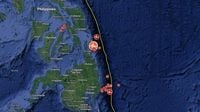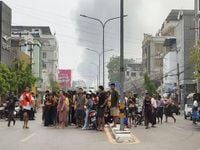In the early hours of October 17, 2025, residents across Mindanao, Philippines, awoke to the unsettling tremors of yet another strong earthquake. According to the United States Geological Survey (USGS), a magnitude 6.1 quake struck near Union, Mindanao, at precisely 23:03 UTC on October 16 (07:03 local time, October 17), shaking communities already on edge from a recent string of seismic events. The European-Mediterranean Seismological Centre (EMSC) also reported the earthquake at magnitude 6.1, with a slightly shallower depth of 59 kilometers compared to the USGS’s 69 kilometers.
The epicenter was pinpointed just 0.1 kilometers west-southwest of Union, a small town with a population of 2,368. The tremors rippled outward, felt in neighboring cities such as Placer (57 km east-northeast), Surigao (67 km east), Tandag (76 km north), and as far as Butuan, a city of over 309,000 people, located 109 kilometers northeast. It’s estimated that 281,000 people experienced moderate shaking, while 4,602,000 felt light shaking and another 4,893,000 sensed weaker tremors, according to The Watchers.
Despite the quake’s strength, authorities were quick to reassure the public. No tsunami threat was issued, and the USGS promptly released a Green alert, signaling a low likelihood of fatalities or significant economic losses. This was a relief for many, especially considering the region’s recent history of destructive earthquakes and the anxiety that often follows such events.
“There is no tsunami threat from this earthquake,” The Watchers reported, echoing official advisories and helping to calm nerves in coastal communities. The population in the affected region resides in a mix of vulnerable and earthquake-resistant buildings, with many homes constructed from heavy wood frames and miscellaneous materials. While these structures can sometimes fare poorly in strong quakes, the latest event did not result in widespread damage or casualties.
Secondary hazards, such as landslides and liquefaction, have been a concern in previous earthquakes in the area. However, the USGS and The Watchers noted that this particular event only triggered limited liquefaction, affecting a relatively small number of residents living in susceptible zones. Landslides were not expected, providing further reassurance to those in hilly or mountainous areas.
This earthquake is the latest in a relentless sequence of seismic activity that has rocked the Philippines since late September 2025. The region, especially the Visayas and Mindanao, has been rattled by a series of strong and damaging quakes, testing the resilience of communities and emergency services alike.
The most devastating of these recent events occurred on October 10, when a magnitude 7.4 earthquake struck off the east coast of Mindanao. That powerful quake left at least nine people dead and more than 900 injured, according to The Watchers. The main shock, which originated at a depth of around 58 kilometers, generated intense shaking across Surigao del Sur, Agusan del Norte, and Davao Oriental. The Pacific Tsunami Warning Center (PTWC) issued a tsunami warning shortly after the quake, but it was quickly canceled as further data ruled out a significant threat.
The aftermath of the October 10 quake saw a flurry of aftershocks, including a robust magnitude 6.7 event in the same region just hours later, and a magnitude 6.0 quake near Aras-asan, Mindanao, on October 11. The USGS has confirmed that these are part of an ongoing aftershock sequence following the main 7.4 event, underscoring the region’s heightened seismicity and the challenges it poses for local communities.
Looking back a bit further, the Philippines endured a particularly deadly earthquake on September 30, 2025, when a magnitude 6.9 quake struck Cebu and Leyte. That disaster claimed at least 69 lives and left more than 200 injured. The tremor caused widespread structural damage across central Philippines, triggering landslides and disrupting transportation in Leyte and Cebu provinces. The scars from that event are still fresh, and each new tremor serves as a stark reminder of the region’s vulnerability.
With so many earthquakes in such a short span, people throughout Mindanao and the Visayas are understandably anxious. Many live in areas where buildings range from robust, earthquake-resistant designs to older, more vulnerable structures. The USGS and The Watchers have both highlighted the mix of construction types in the region and the importance of ongoing efforts to improve building standards and disaster preparedness.
Despite the frequency of strong earthquakes, the Philippines is no stranger to seismic activity. The country sits along the Pacific "Ring of Fire," a zone notorious for its high levels of tectonic activity. Earthquakes and volcanic eruptions are part of life here, and over the years, communities have developed a certain resilience and readiness. But as the recent sequence of quakes has shown, even the most prepared populations can be tested by nature’s unpredictability.
For now, the focus remains on recovery and vigilance. Emergency response teams have been mobilized, and officials continue to monitor aftershocks and assess infrastructure for damage. The quick issuance of alerts and advisories by agencies like the USGS and PTWC has played a crucial role in keeping the public informed and minimizing panic. Local governments are also stepping up public education campaigns, reminding residents of the importance of earthquake drills, emergency kits, and safe evacuation routes.
While the October 16 quake near Union, Mindanao, did not result in the devastation seen in previous events, it serves as a sobering reminder of the region’s ongoing seismic risks. For many, the experience was unsettling, but it also reinforced the importance of preparedness and community solidarity in the face of natural disasters. As the aftershock sequence continues, residents remain alert, hoping for calmer days ahead but ready to respond should the earth tremble once more.
In neighboring Indonesia, the same day saw a magnitude 6.7 earthquake strike Papua, adding to the sense of regional seismic unease. Though details on the impact in Papua remain limited, the coincidence of two significant earthquakes in Southeast Asia within hours of each other highlights the shared challenges faced by countries along the Ring of Fire.
As governments, scientists, and citizens work together to strengthen resilience and reduce risk, the events of October 2025 will undoubtedly shape future strategies for disaster management and community safety. The earth may be restless, but the spirit of those who live atop its shifting plates remains unbroken.


